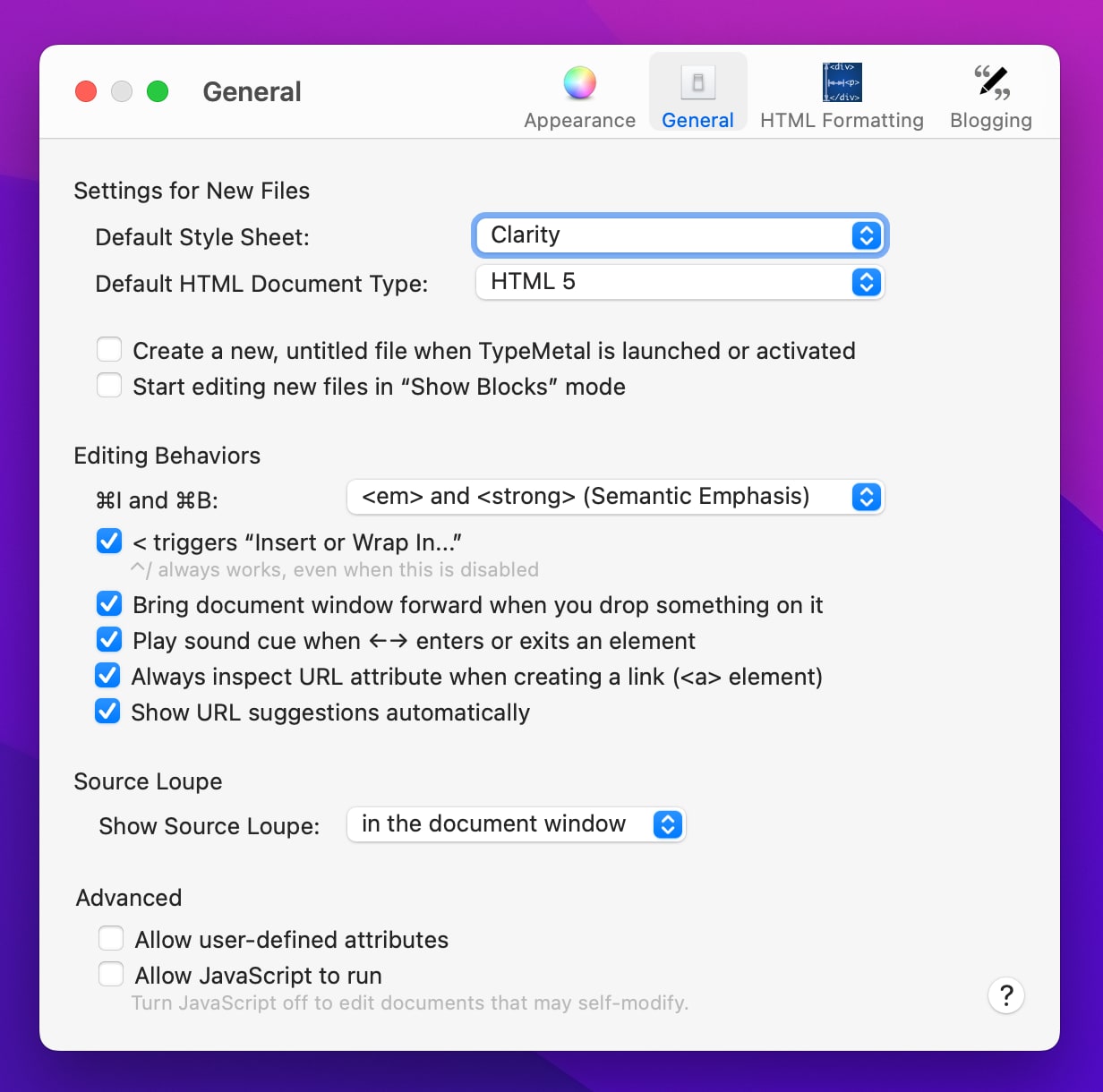General Settings
TypeMetal’s “General” settings pane lets you adjust TypeMetal’s general editing and new-document-creation behaviors to your liking.

Settings for New Files
Tell TypeMetal which CSS style sheet (if any) you’d like new HTML files to start out using.
You can also specify the default HTML document type for new HTML files. (“HTML 5” is generally recommended for new work, unless you have a reason to use some other document type.)
By default, if when you launch TypeMetal or make it the active application there is no HTML file already open, TypeMetal will create a new, Untitled HTML file for you. You can disable this behavior in the General settings panel if you like.
You can also tell TypeMetal whether to jump directly into “Show Block Structure” mode (a.k.a. "Block Mode") when it creates a new HTML file or opens an existing one. (For automatically reopened files, TypeMetal remembers whether you left the window in Block Mode.)
Editing Behaviors
The “⌘I and ⌘B” setting lets you specify the emphasis elements that TypeMetal binds to the ⌘I and ⌘B keystrokes. The default setting of “<em> and <strong> (Semantic Emphasis)” is recommended for new content, but you can change the setting to “<i> and <b> (Explicit Italics and Bold)” if you prefer.
Regardless of this setting for the ⌘I and ⌘B convenience bindings, all of the emphasis elements are always available via the general element completion UI.
Normally, typing a ‘<‘ character summons TypeMetal’s general element completion UI. When you want a literal ‘<‘ character in your text, you type ‘<‘ a second time to dismiss the completion UI. You can disable this behavior by unchecking “< triggers ‘Insert or Wrap In…’”. You can always type ⌃/ to summon the completion UI.
There’s a checkbox that lets you control whether TypeMetal brings a document window to the front when you drop something into it. This can provide for more convenient writing if you drag-and-drop content into your documents often, as the destination document window is then focused for further editing and typing.
You can control whether TypeMetal plays a sound cue when it shows a notification bezel for entering or exiting an element. Uncheck the “Play sound cue…” box if you’d like to silence those notification bezels.
Normally, when you create a link (<a> element), TypeMetal automatically opens the attribute editor for the new element’s “href” property, to offer you an opportunity to inspect the destination URL and optionally choose, paste, or type a different URL. As part of this, TypeMetal offers optional autocompletion to a list of suggested URLs gathered from your pasteboard history, the current document, and possibly other files in the enclosing folder tree. If you find this confirmation step is usually unwanted, you can uncheck “Always inspect URL attribute when creating a link (<a> element)”, which tells TypeMetal not to open the attribute editor for a new link if it’s reasonably likely that you got the link you wanted. (Currently, this causes TypeMetal to open the attribute editor for remote (http/https) URLs, but not for relative URLs to other files in your project.) You can also uncheck “Show URL suggestions automatically” to suppress automatic showing of the URL autocompletion list when editing a URL attribute. (You can type ⌘↓ to show the completion list if desired, when editing the value of a URL attribute.)
Source Loupe Management
If you prefer, you can have TypeMetal embed a document’s Source Loupe below the content editing area, instead of floating it in a separate window.
In the “Show Source Loupe” popup button, choose “in the document window” instead of “in a floating window”. This setting applies to all TypeMetal document windows.

The embedded Source Loupe allows you to scroll through your document’s HTML markup, click and drag to select the corresponding parts of your document, click an element’s start or end tag to select the element, and double-click to open the attribute editor. See the Source Loupe help page for details.
Allowing User-Defined Attributes
If you check the “Allow user-defined attributes” box, TypeMetal’s attribute editor will allow you to add attributes with arbitrary names to your HTML elements. (To override TypeMetal’s automatic attribute name completion and force a custom attribute name, you’ll need to hold the Option key while pressing the Return key or spacebar in the attribute search field. See Editing Element Attributes.) TypeMetal also won’t show “proprietary attribute” warnings for attributes that aren’t named in the HTML spec.
When this box is unchecked, TypeMetal only allows attribute names that are defined in the HTML specification for your file’s document type, and shows a “proprietary attribute” warning in the path bar’s popup validation issue list.
Enabling JavaScript Execution
Normally, it’s best to play it safe and leave JavaScript disabled when editing your documents, since some scripts may modify a document’s structure or content — not something you’d usually want to allow during editing.
If you’d like to allow JavaScript code in your documents to be run, however, you can enable JavaScript execution using the “Allow JavaScript to run” checkbox in TypeMetal’s General settings panel. This setting affects all of your TypeMetal document windows.
You may sometimes find it necessary to close and reopen an already opened file, if enabling of JavaScript doesn’t immediately take effect. Some documents rely on scripts that are triggered “on load”.
When you’re done working with JavaScript, it’s generally a good idea to uncheck “Allow JavaScript to run”, just so you don’t forget you left it on. This avoids potential problems with self-modifying documents in future editing sessions.
Next
A separate settings pane enables you to set your default HTML formatting settings.